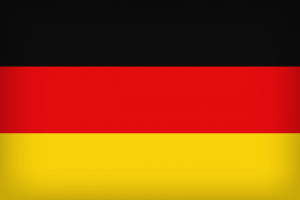Language/German/Grammar/Noun-and-Gender
 Հայերէն
Հայերէն Български език
Български език 官话
官话 官話
官話 Hrvatski jezik
Hrvatski jezik Český jazyk
Český jazyk Nederlands
Nederlands English
English Suomen kieli
Suomen kieli Français
Français עברית
עברית हिन्दी
हिन्दी Magyar
Magyar Bahasa Indonesia
Bahasa Indonesia فارسی
فارسی Italiano
Italiano 日本語
日本語 Қазақ тілі
Қазақ тілі 한국어
한국어 Lietuvių kalba
Lietuvių kalba Νέα Ελληνικά
Νέα Ελληνικά Şimali Azərbaycanlılar
Şimali Azərbaycanlılar Język polski
Język polski Português
Português Limba Română
Limba Română Русский язык
Русский язык Српски
Српски Español
Español العربية القياسية
العربية القياسية Svenska
Svenska Wikang Tagalog
Wikang Tagalog தமிழ்
தமிழ் ภาษาไทย
ภาษาไทย Türkçe
Türkçe Українська мова
Українська мова Urdu
Urdu Tiếng Việt
Tiếng Việt
| ◀️ Subject and Verb — Previous Lesson | Next Lesson — Greetings and Goodbyes ▶️ |
German grammar can seem complex at first, but once you understand the basic sentence structures, you'll be able to build more complex sentences with ease. In this lesson, we will focus on the concept of nouns and gender in German. Understanding the gender of nouns is crucial for correct sentence formation and will help you expand your vocabulary. Let's dive in!
Nouns in German[edit | edit source]
Nouns, or "Substantive" in German, are words that name people, places, things, or ideas. Unlike in English, German nouns have grammatical gender. There are three genders in German: masculine, feminine, and neuter. The gender of a noun determines the articles, adjectives, and pronouns used with it.
For example, let's look at the noun "house" in German:
| German | Pronunciation | English |
|---|---|---|
| das Haus | das hous | the house |
In this example, "Haus" is a neuter noun, so it is accompanied by the article "das" in the nominative case. Pay attention to the definite article "das," as it indicates the gender of the noun.
Der, Die, Das[edit | edit source]
The definite articles in German are "der" for masculine nouns, "die" for feminine nouns, and "das" for neuter nouns. These articles change depending on the case and number of the noun. Let's take a look at some examples:
| German | Pronunciation | English |
|---|---|---|
| der Mann | der man | the man |
| die Frau | dee frow | the woman |
| das Kind | dass kint | the child |
In these examples, "Mann" is a masculine noun, "Frau" is a feminine noun, and "Kind" is a neuter noun. As you can see, the articles change depending on the gender of the noun.
Gender Patterns[edit | edit source]
While there are some general patterns to help determine the gender of a noun, it's important to note that there are many exceptions. However, here are some guidelines to keep in mind:
1. Masculine nouns often end in -er, -el, -en, -ig, -ling, -or, -är, and -ismus. For example: der Vater (father), der Apfel (apple), der Tisch (table).
2. Feminine nouns often end in -e, -ei, -heit, -keit, -ie, -ion, -schaft, and -ung. For example: die Frau (woman), die Tür (door), die Freiheit (freedom).
3. Neuter nouns often end in -chen, -lein, -ment, -um, and -tum. For example: das Mädchen (girl), das Büchlein (booklet), das Parlament (parliament).
Remember, these are just general guidelines, and there are exceptions to each rule. The best way to determine the gender of a noun is to learn it along with its article.
Plural Nouns[edit | edit source]
In addition to gender, nouns in German also have plural forms. The plural form of a noun is formed by adding an -e, -en, -n, or -s to the end of the singular noun. Here are some examples:
| German | Pronunciation | English |
|---|---|---|
| der Hund | der hund | the dog |
| die Hunde | dee hoon-duh | the dogs |
| das Haus | das hous | the house |
| die Häuser | dee hoi-zer | the houses |
As you can see, the plural form of "Hund" is "Hunde," and the plural form of "Haus" is "Häuser." Pay attention to the changes in article and noun endings when forming the plural.
Summary[edit | edit source]
In this lesson, we covered the concept of nouns and gender in German. Remember that nouns in German have three genders: masculine, feminine, and neuter. The gender of a noun determines the articles, adjectives, and pronouns used with it. We also discussed the definite articles "der," "die," and "das," which change depending on the gender, case, and number of the noun. Lastly, we touched on plural nouns and how they are formed in German.
Continue practicing and building your vocabulary by learning the gender of nouns along with their articles. This will help you construct more complex and grammatically correct sentences in German. Viel Erfolg (Good luck)!
Sources[edit | edit source]
- German Noun Gender: How to Stop Memorizing | German with Laura
- Dear Duolingo: How do you know the gender of German nouns?
- der, die, das – Gender of Nouns in German Grammar
Other Lessons[edit | edit source]
- Talking About Obligations
- 0 to A1 Course
- Past Tense
- Descriptive Adjectives
- How to Use Be
- Imperative Tense
- Separable Verbs
- Past Tense Part 1 Perfect Tense
- Prepositions
- Subject and Verb
| ◀️ Subject and Verb — Previous Lesson | Next Lesson — Greetings and Goodbyes ▶️ |

